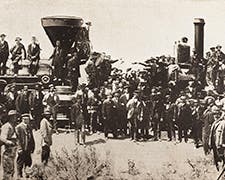Cultural Impact of Building the Transcontinental Railroad
Numerous "hell on wheels" towns proliferated along the Union Pacific construction route from Omaha, Nebraska, to Promontory Summit, Utah. The towns were famous for their rapid growth and infamous for their lawlessness. Many of the Union Pacific railroad workers were young Civil War veterans, many were Irish immigrants, and almost all were single. The close attachment to the railroads meant a constant stream of transient residents and a mixing of ethnic groups under the banner of the Pacific Railroad. The towns were often temporary and made up of tents and cheap board structures that easily could be dismantled and moved to the next location. The towns offered everything from dentistry to hardware supplies to saloons and prostitutes. Although many Hell on Wheels towns disappeared as the railroad moved west, several communities, such as Laramie, Wyoming, endured and thrived in later years as railroad repair facilities and branch line terminals.
The Union Pacific's progress through the upper plains also put construction workers in the path of the Plains Indians. Civil War veteran General Grenville Dodge led the Army's forces against the Indians following the Civil War. Under his command, army troops battled Sioux, Arapahoe, and Cheyenne in Wyoming, Colorado, and western Nebraska. The November 1864 Sand Creek Massacre in Colorado, in which U.S. Army forces raided and killed 150 Cheyenne Indian villagers, and the Cheyenne retribution at Julesburg, Colorado, a few weeks later were commonplace along the future route of the railroad. Dodge became chief engineer of the Union Pacific in 1865 and the railroad's encroachment on Native American land led to continued conflicts during the construction of the westward line. Completion of the railroad lines led to the eventual loss of Native American homelands as they were forced onto reservations.
Despite their confrontations with several Native American nations, the Union Pacific found an ally in the Pawnees, a tribe friendly to the U.S. government. Dodge recruited Pawnees to serve as a protection force against the Sioux as the railroad made its way through the plains. In return, railroad officials gave Pawnees free passage on their trains. In a macabre demonstration, Thomas Durant recruited Pawnees to stage a mock raid on trains as entertainment for dignitaries riding as part of the Union Pacific's 100th meridian celebration in October 1866.
Mormon leaders, though supportive of the transcontinental railroad's advance through Utah, worried that the railroad would encroach on the character of their society. Indeed, sermons of the day focused on three changes, both good and bad, coming with the railroad: increased immigration of Mormons to Utah, economic help in the territory, and a proliferation of undesirable people moving to the Kingdom. To mitigate the unsavory elements of the railroad, Brigham Young established a School of the Prophets composed of church leaders to direct an economic plan of action. To show his support for the transcontinental railroad, Brigham Young purchased fives shares of stock of the Union Pacific Railroad valued at $1,000 per share.
In May 1868, Young signed a $2,125,000 million contract with the Union Pacific to build the railroad line from Echo to the shores of the Great Salt Lake, a distance of 150 miles. In the fall of the same year, Young contracted with Central Pacific officials to build the railroad from Humboldt Wells, Nevada, to Ogden, Utah, a distance of 200 miles.
Chinese immigration began with the discovery of gold in California in 1848. Competition for mining jobs, however, quickly turned to racial problems in the state. During the 1850s the unequal treatment of African-Americans extended to the Chinese. During the 1850s and early 1860s, the state legislature and numerous local governments passed anti-Chinese laws and imposed taxes to discourage Chinese immigration and to deny civil rights to those working in the U.S. But when the Central Pacific began laying tracks in 1865, white labor was scarce and unreliable. Charles Crocker's solution to the labor shortage was to hire out-of-work Chinese.
In February 1865, Crocker and his subordinate James Strobridge employed 50 Chinese workers as an experiment to verify their capabilities of performing the arduous labor of laying tracks. They passed the test. Within a few months, the Central Pacific's Chinese workforce began their assault on the Sierra Nevada range, the workers blasting through the most difficult terrain of the entire railroad line. Receiving only $1 a day in salary and working 12 hour shifts six days a week, the Chinese lived in makeshift camps, sometimes in the tunnels they were blasting, and were often called upon to perform the most life-threatening construction duties.
In July 1868, Secretary of State William Seward concluded the Treaty of Trade, Consuls, and Emigration with China. Known as the Burlingame Treaty, named after consul Anson Burlingame, the treaty gave China favored nation status and was meant to increase trade between the U.S. and China. A corollary component of the treaty increased the number of Chinese immigrants and provided civil rights protection for Chinese living and working in the U.S. Immigration increased soon after the treaty was signed: 11,085 Chinese immigrants in 1868, and 14,994 Chinese immigrants in 1869. At the height of the transcontinental construction period, the Central Pacific employed over 12,000 Chinese workers, which was more than 90 percent of the company's workforce.
The Central Pacific released Chinese workers in April 1869 with the completion of the railroad at Promontory, Utah. Racial tensions increased in the West as the workers returned to California in search of employment. In 1882, Congress passed the Chinese Exclusion Act that barred future Chinese immigration and denied naturalization for those already in the U.S. The Act stood in place for 60 years until President Franklin Roosevelt repealed it in 1943 during World War II.

